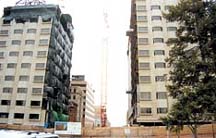Although the high-profile job was a tough challenge for the 27-year-old business, the project can serve as a case study for the success that can result when builders, designers, and HVAC contractors work closely with one another.
DESIGN AND ASSIST
In the spring of 1999, work began on the Michigan Legislative Building. The 300,000-square-foot facility, located in downtown Lansing, was constructed at a site formerly occupied by two separate buildings. The nine-story Lansing Board of Water and Light Building was totally renovated, and five more floors were added. Across the street, another building was razed and an 11-story building was constructed. The two buildings were then connected by a bridge or crosswalk, which extended from the fifth floor of each building.
T.H. Eifert approached the owner of the building with a proposal to assist in the design. Dirk Powell, business development for T.H. Eifert, explained that a design assist approach to a project allows the mechanical contractor to work closely with designers and architects to make sure that the appropriate HVAC systems are selected. The contractor works with the builders to guarantee that the installation is within budget, the systems are adequate for the project, and any kind of construction issues are reviewed and properly handled.
Powell said that the owners and designers had some concepts in mind. It was the job of T.H. Eifert Inc. to take those ideas and make sure they worked for the project.

HIGH EXPECTATIONS, HIGH DEMANDS
Eifert said that the project had a number of challenges. Some of these challenges were addressed in the systems that were chosen for the building.First, space constraints were a major issue. The design team for the project addressed this concern by choosing a high velocity/high pressure air distribution system.
“Each floor had a dedicated air-handling system with a relatively high level of independent zoning controls,” said Eifert.
Powell explained that zoning was not only chosen to save space, but to provide a higher comfort level for the building occupants. It was decided by T.H. Eifert and the design team that it wouldn’t be enough to make each floor a zone or to group several offices into one zone. Instead, each office was hooked up with a thermostat so that each occupant would be able to decide his or her own comfort level.
T.H. Eifert also installed a waterside economizer system. This was due in part to the limitations involved in installing a large outside air and supply air duct.
These space constraints were one of the biggest hurdles for installers. Eifert explained that because of limited storage space and restricted access to various floors, materials had to be fabricated off-site and delivered to the project on the third shift. First and second shifts then installed the products as they were available.
“Ductwork was detailed on a CAD system and sent to the manufacturer,” said Eifert. “The manufacturer adjusted duct sizing and shape, verified fan pressure requirements, and then made the duct.”
To complicate matters, Eifert said that the project was on a “fast track” schedule. From the start of construction, before the design was completed, the state of Michigan began furnishing the building in 13 months.
Another issue came up with the former Board of Water and Light building. Eifert said that the building contained asbestos, which delayed access to several areas. Work on the project was then sequenced to avoid the areas with the asbestos.
Also, Eifert explained that because a new structure was built upon an existing one, additional concrete support was needed through the building. This, too, interfered with new work.
SUCCESS IN THE END
T.H. Eifert was able to overcome the various problems associated with the Michigan Legislative Building. Eifert said that although there were difficult conditions to deal with, the project was still finished in a short period of time. The building did require a commissioning process. In the end, the mechanical systems worked as intended after a few locations were modified after comfort complaints.The design/assist process has been beneficial for T.H. Eifert, and the company believes that the process is beneficial for all parties involved with the construction of the building.
“Without integrating the trade contractors in the programming and design phase, many opportunities for efficiency are lost,” said Eifert.
Eifert further explains that a design and assist approach accelerates the schedule for a project without running the risk of reworking systems or installing incompatible systems.
T.H. Eifert Inc. believes that the secret to making design/assist projects successful is communication and flexibility.
“This approach requires dedication and highly experienced personnel that must be able to leave their egos at the door,” said Eifert. “Not all contractors are compatible with designers, and vice versa. You must be able to speak one another’s language, understand the challenges that each function faces, and always keep the owner’s best interests in mind.”
Publication date: 10/28/2002





